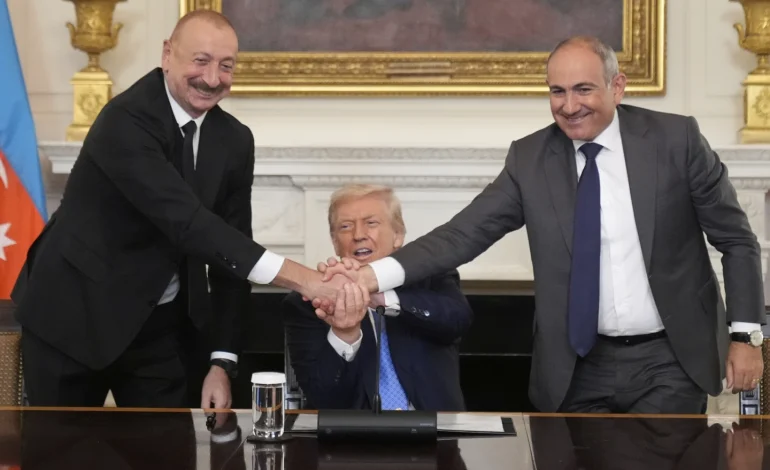A splashy Oval Office declaration and a 17-chapter draft look great on camera. But unless Yerevan trades PR for precision (verification, guarantees, and enforceable terms), the government’s rhetoric will keep outrunning the facts.
On the world stage, Armenia is suddenly everywhere: photo-ops in Washington, handshakes in Sharm el-Sheikh, triumphant talk of a “historic” breakthrough with Azerbaijan. But strip away the pageantry and the self-congratulation, and you’re left with a nagging problem: the Pashinyan government keeps selling symbolism as substance.
Start with the headline claim. In Egypt, Donald Trump told the “Peace Summit” that he stopped the Armenia–Azerbaijan war “in one hour,” pointing to an Oval Office meeting with Nikol Pashinyan and Ilham Aliyev. The story is made for TV: two leaders seated at opposite ends of the room, an hour later “they were hugging,” and “now they’re friends and getting along great.”
It’s irresistible politics. It’s also not a peace agreement.
Yes, Washington produced a seven-point declaration on August 8: foreign ministers to initial a text for a peace and inter-state relations treaty; OSCE Minsk structures to be dissolved; unobstructed connectivity between Azerbaijan and Nakhchivan “on the basis of state sovereignty, territorial integrity and jurisdiction”; and a framework for TRIPP, the “Trump Route for International Peace and Prosperity,” to be scoped on Armenian territory with U.S. and third-country partners. Three days later, Armenia’s MFA published a 17-chapter initialled draft. On paper, it’s the furthest the sides have come toward codifying a post-Karabakh settlement.
But “initialled” isn’t “implemented,” and declarations aren’t deterrence. The real work (border demarcation, transit modalities, security guarantees, sequencing, monitoring, dispute resolution) remains exactly where it always gets hard: in the details. Meanwhile, the government’s domestic messaging treats the optics as the outcome.
Worse, Yerevan is leaning into that optics-first strategy. The Sharm el-Sheikh moment, when Pashinyan reportedly had to introduce himself to Trump two months after the White House ceremony, was a small but telling scene. If the August choreography truly reset Armenia’s strategic status, why is the prime minister still playing for recognition in the hallways? This is not an insult; it’s a reality check about leverage. If you’re the indispensable architect of peace, you don’t have to re-introduce yourself.
The larger issue is credibility. When a government blurs the line between spin and statecraft on existential questions, the public loses the ability to map expectations to facts. That’s dangerous in two ways:
It crowds out scrutiny. By framing August 8 as a done deal rather than a starting point, the administration sidesteps tough questions: What concrete security mechanisms back “unobstructed” routes? What reciprocal guarantees does Armenia get for sovereignty and jurisdiction? Who arbitrates breaches? How will the dissolution of the Minsk format be offset in multilateral forums where Armenia previously had a platform?
It inflates political risk. Overselling breakthroughs builds a pressure balloon that eventually bursts. If delivery lags the narrative, public patience collapses faster, and with it, negotiating space. A foreign-policy strategy premised on mood management is a strategy without shock absorbers.
None of this argues against a peace treaty. On the contrary: a verifiable, enforceable deal that locks in sovereignty, ensures secure connectivity under Armenian law, and embeds outside guarantees would be the most important statecraft achievement since independence. But getting there requires less victory lap, more verifiable milestones.
What would responsible messaging look like?
- Admit what’s on paper vs. what’s in force. Initialling a 17-chapter text is progress. Ratified, monitored implementation is the finish line.
- Spell out the trade-offs. Connectivity can be a win for Armenia, if jurisdiction, policing, customs, and liability are unambiguous and enforceable. Say how.
- Put verification front and center. Who monitors, what’s reported, what triggers penalties, what’s the snap-back if terms are breached?
- Stop personalizing diplomacy. Peace is not a set-piece solved by proximity to a U.S. president, whoever he is. It’s institutions, instruments, and incentives.
Pashinyan’s team is right about one thing: August 8 could be a hinge moment. But hinges only matter if the door actually swings and locks. Until then, treating photo-ops as peace risks detaching the country from reality at the exact moment it needs clarity most.









The latest news in your social feeds
Subscribe to our social media platforms to stay tuned